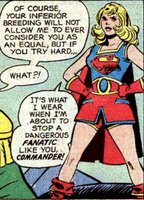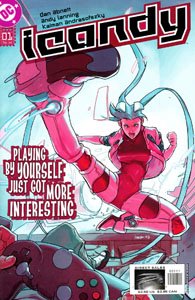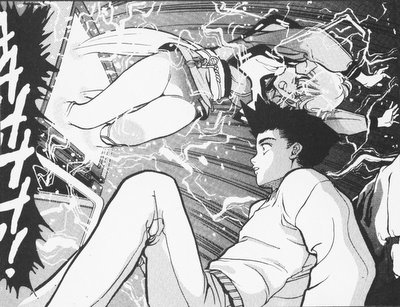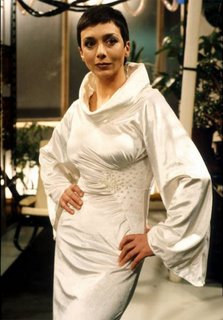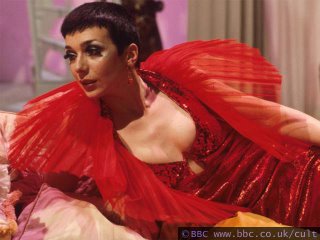It's taken a long time to get this episode written because the comics it covers are so, so bad that it was hard to work up the enthusiasm to read them. But here we are at last.Wonder Woman v1 287 - 299Dc Presents 41I probably should have included one more issue in the previous entry as we get a second "guest writer" issue before the comic gets yet another makeover.
Marv Wolfman pops up with a story that guest stars the Teen Titans. It's been a while since I read any of Marv's work but I remembered him as a decent writer. Sadly it's not too evident in this story which opens with Wonder Girl being shot at by generic minions in hooded robes. She does the usual bullets and bracelets routine - which is a good trick with lasers (1) but eventually a hit in the arm from one of these "laser guns" causes her to fall unconscious rather than burning a hole through her.
So the minions kidnap Wonder Girl and the Titans call Wonder Woman in to help rather than go deal with it on their own. (2) And this is the whole point because it was all a convoluted plot by Doctor Cyber (3) to grab Wonder Woman and steal her face. Eerily, there is one panel that has unintended resonance decades after it was drawn, when Wonder Woman's invisible robot plane goes out of control.
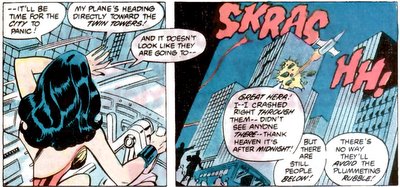

And then it's makeover time but not in
Wonder Woman #288; first we have to slip over to
DC Presents #41 for what is called a "preview" but is in fact a self-contained Wonder Woman 14 page mini-comic (4). Along with new writer Roy Thomas and art by Gene Colan even the cover logo gets a renovation in a story that replaces the stylised eagle motif on Wonder Woman's chest for the =w= symbol we are more familiar with today.
The new chest symbol was a result of DC president Jennette Kahn's plan to to celebrate Wonder Woman's 40th anniversary by establishing a Wonder Woman Foundation to honour outstanding women over 40 (5). I cannot find any information about this foundation beyond 1986 so I can only assume that it no longer exists (6), but I did find some references to women who had received the award in the mid-80's (7).

In the story the women of the Wonder Woman Foundation present Wonder Woman with her new bustier and after thinking it over while beating up on Hercules and outracing Hermes she agrees to wear it. It's a nice way of tying the comic in with the real life foundation, but in context it appears that the amazon is agreeing to wear the Foundation's logo rather than them adopting hers and it comes off looking like she is now taking advertising on her costume like some sports player with a Nike logo on their shirt (8).

Reports suggest that Roy Thomas was keen to work on Wonder Woman, and he does seem to have done some homework, giving us a historical and mythological context to traditional WW villain Mars' sponsoring of new enemy Silver Swan and the introduction of an Earth 1 version of Doctor Psycho, and yet his research isn't quite up to date as he has Steve Trevor and Diana Prince working for military intelligence (9) instead of the Air Force, and places Paradise Island in the Bermuda Triangle (10). Would be nice if they could decide once and for all whether to call WW's mom Hippolyte or Hippolyta and just stick to it, too.
Diana Prince briefly gains a new roommate and wouldn't you know it, it's the Silver Swan in her secret identity of Helen Alexandros. She's supposed to be hideously ugly but I don't see it, myself. I know that it's easy to get hung up on any little imperfection, but the way the heavy handed narration goes on you'd think she looked like a troll, rather than a cute girl with a couple of zits.

The story itself is confused and muddy. Silver Swan is under orders to kill Wonder Woman but sometimes she helps her out, even though she hates her. Why does she hate Wonder Woman? I don't know. Doctor Psycho turns into Wonder Man whenever Steve Trevor falls asleep, and he is stronger than WW because Steve thinks he is, apparently. At the end of the story Mars takes Swan girl's powers away because she hasn't yet killed Wonder Woman; you'd think a god would have a little more patience, particularly when this particular chore is one he's failed at so often, himself.
Then we get into a big story which, if it happened today would probably be a company wide event, but (thank Athena) here is just a 3 parter with a lot of guest stars. It involves one of those omniscient godlike beings that seem to spend so much time poking around in other people's business, and who appears to be a cross between the Celestials and the Beyonder. He gives planets marks out of 10 and if they don't get a high enough grade he destroys them, or in this case arranges fights for a lot of super-heroines. In the end some even more godlike beings take him home for a spanking. It's pure cack.
Just when you feel like you have hit the bottom of the barrel, something like the next story comes along and you realise that the barrel was a whole lot deeper than you could possibly imagine. This one involves people getting brainwashed by a video game. Okay, so that was a relatively original concept in 1982, but where it hits the wall of dumb is when you find out that the evil video game was created by the villain, General Electric (11) while he is in prison, in the prison workshop. After he learns electrical engineering. But not programming. Even if this were possible we are then given no information about how this game has gone from being a prison prototype to a mass market success.
In fact the stupid game is so incredibly successful that he could just rake in the profits and enjoy the fruits of his labour, but no, it's all a means to an end. What that end may be is never explained, although it seems to involve gathering a private army. But he never actually does anything with it, so who knows? For something that started at barrel-bottom, it's hard to believe that it could get worse, but it does, ending with a dire
Tron steal that exposes the writer's utter ignorance of everything he is writing about. Didn't anybody ever research their subject matter during this period? Or did they just not care?
Apparently Dan Mishkin did, and in the lead up to the big 300 he brings us a story built on the myth of Beleraphon, who has been hiding out on Themiscyra (12) until some greek terrorists turn up and he enlists them to attack Paradise Island to get the purple healing ray and restore his sight (13).

Wow. The novelty of having a villain with motivation that makes sense and a clear cut plan of action is staggering after the last few dozen issues. There's also an interesting subplot involving a skeleton dressed in a Wonder Woman outfit. Sadly, this is completely blown by the use of the new =W= insignia, since it relates back to events long before the new insignia was created, but the error is corrected by the time it becomes the main plot in issue #301.
But I'm going to save that for next time.
Next: The only way to go is up (at least that's the theory).Notes
1. amazon training is so good that their reflexes are faster than light now?
2. Did the Titans ever call on a related adult when one of their number was in trouble? Ever?
3. remember Doctor Cyber?
4. though at a time when the amazon princess was only getting 17 pages of story a month, it's practically a full comic
5. it was also a better brandname logo and easier to trademark
6. although a Wonder Woman Foundation does still exist in post-Crisis DC continuity
7. Such as Rosa Parks (pictured above).
8. Nike being the greek goddess of victory long before she got into sports footwear
9. which they haven't done since 1967
10. entirely an invention of the TV show
11. ludicrous but true
12. which it turns out isn't another name for Paradise Island after all, but the previous home of the Amazons thousands of years ago
13. He was blinded by Zeus when he attempted to fly to Olympus on Pegasus. This version says Zeus hurled him back to Earth, causing his injuries, but according to Brewer's Phrase and Fable Zeus sent a mayfly to sting the flying horse and throw him off. But I guess that lacks the same drama.
 Flower from Kamandi wears a torn red skirt and no top, and appears to have her long hair stapled to her chest. While this is entirely consistant with the circumstances of the story, you have to wonder why Kirby chose to have a female character running around topless in a comic where sight of a stray nipple would be strictly forbidden, requiring such a clumsy device to keep her decent.
Flower from Kamandi wears a torn red skirt and no top, and appears to have her long hair stapled to her chest. While this is entirely consistant with the circumstances of the story, you have to wonder why Kirby chose to have a female character running around topless in a comic where sight of a stray nipple would be strictly forbidden, requiring such a clumsy device to keep her decent. A typical way of showing when a good female character has gone bad is to put her in some kind of bondage/fetish costume. A prime example is Sue Richards of the Fantastic Four, whose repressed urges were released when she donned the fetish costume of Malice. It is actually a very good story empowering the Invisible Woman, unlike the semi-sequel where the return of the Malice persona is signalled by Sue taking a pair of scissors to her regular costume and cutting a lot of holes in it, and then biting the head off anyone who comes near her.
A typical way of showing when a good female character has gone bad is to put her in some kind of bondage/fetish costume. A prime example is Sue Richards of the Fantastic Four, whose repressed urges were released when she donned the fetish costume of Malice. It is actually a very good story empowering the Invisible Woman, unlike the semi-sequel where the return of the Malice persona is signalled by Sue taking a pair of scissors to her regular costume and cutting a lot of holes in it, and then biting the head off anyone who comes near her. Costumes with only one pants leg never work, even when drawn by Alan Davis.
Costumes with only one pants leg never work, even when drawn by Alan Davis. Not many comic characters could pull off a tailcoat and fishnets, but Zatanna only works if that is what she is wearing. As a stage magician it is entirely consistant for her to wear such an outfit
Not many comic characters could pull off a tailcoat and fishnets, but Zatanna only works if that is what she is wearing. As a stage magician it is entirely consistant for her to wear such an outfit 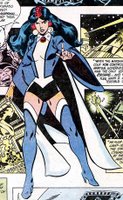 and it's only when they try to make her look more superheroey that it all falls apart. In the recent mini-series Grant Morrison puts her in a variety of absurd cheesecake outfits but they work because they look like stage costumes,
and it's only when they try to make her look more superheroey that it all falls apart. In the recent mini-series Grant Morrison puts her in a variety of absurd cheesecake outfits but they work because they look like stage costumes,  wheras the two she wore while an active member of the Justice League completely jar with her personality.
wheras the two she wore while an active member of the Justice League completely jar with her personality.










